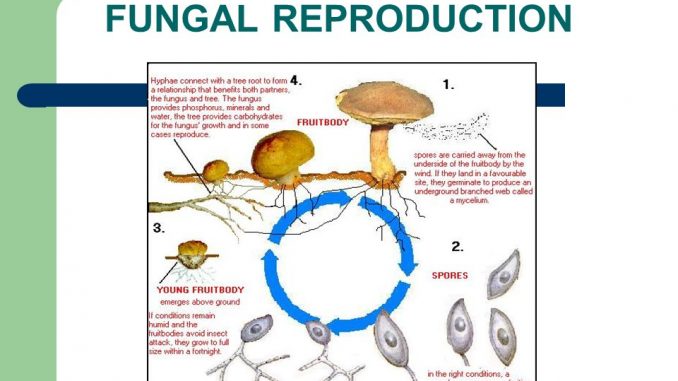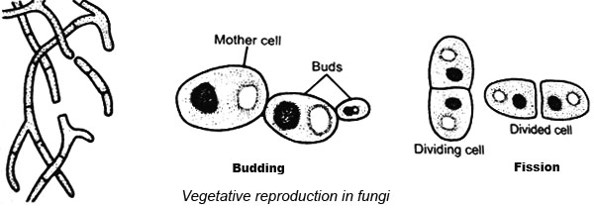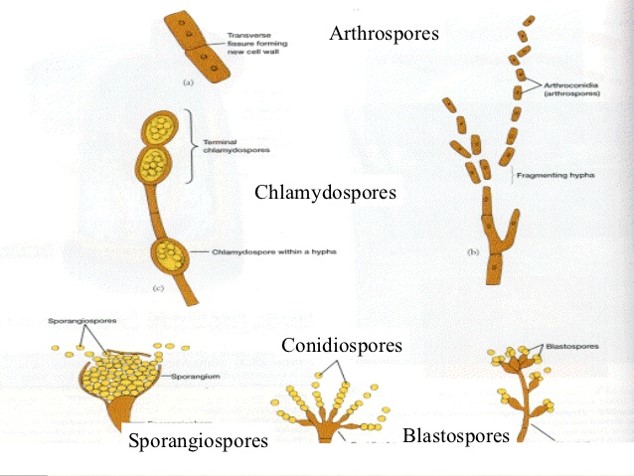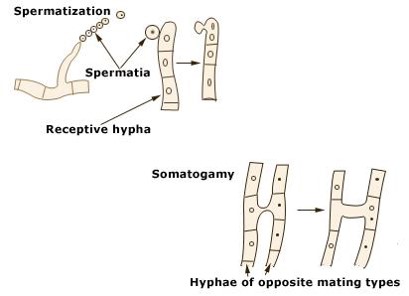
Reproduction in fungi: asexual and sexual methods
Asexual reproduction in fungi:
- fission of somatic cell
- Budding of somatic cell
- Fragmentation or disjoining of hyphae
- Asexual spore formation

1. Fission:
- In binary fission a mature cell elongates and its nucleus divides into two daughter nuclei.
- The daughter nuclei separates, cleaves cytoplasm centripetally in the middle till it divides parent protoplasm into two daughter protoplasm.
- A double cross wall is deposited in the middle to form two daughter cell.
- Ultimately the middle layer of double cross wall degenerates and daughter cells are separated.
- Examples: Saccharomyces pobbe, Psygosaccharomyces
2. Budding:
- The cell wall bulge out and softens in the area probably by certain enzymes brought by vesicles.
- The protoplasm also bulge out in this region as small protuberance.
- The parent nucleus also divides into two, one of the daughter nucleus migrates into bud, the cytoplasm of bud and mother remain continuous for some time
- As the bud enlarges, a septum is laid down at the joining of bud with mother cell. Then bud separates and leads independent life.
- Some time, bud starts reproducing while still attached with mother cell. This gives branching appearance.
- Budding is the typical reproductive characteristics of Ascomycetes.
- Examples: yeast
3. Fragmentation:
- In some fungi, fragmentation or disjoining of hyphae occurs and each hyphae become a new organism
4. Asexual spore of fungi:
- Spore formation is the characteristic feature of fungi.
- Different fungi forms different types of spore,

Types of asexual spore:
i. Sporangiospore:
- These asexual spore are produced in a sac like structure called sporangia (singular;saprangium).
- Sporangium are produced at the end of special aerial hyphae called sporangiophore
- Sporangium contains large numbers of haploid spores, which are released by rapture of sporangial wall
- Examples: Rhizopus
ii. Conidiospore:
- Conidiospore or conidia are single celled, bicelled or multicelled structure born on the tip or side of aerial hyphal structure called conidiophore
- Conidia are different from sporangiospore as these are not produced inside sporangium or any sac like structure.
- Conidia are born singly or in chain
- Examples: Penicillium, Apergillus
iii. Arthrospore:
- Arthrospore are very primitive type of spore formed by the breaking up of fungal mycelium
- A spore is formed by separation followed by fragmentation of hyphae
- Examples: Trichosporium, Geotrichum, Coccididious imitis
iv. Chlamydospore:
- These are usually formed during unfavorable condition and are thick walled single celled spore, which are highly resistant to adverse condition.
- Hyphal cell or portion of hyphae contracts, loose water, round up and develops into thick walled chalmydospore.
- When favorable condition returns, each chlamydospore give rise to a new individual fungi.
- Examples: ascomycetes, basidiomycetes, zygomycetes,
- Histoplasma capsulatum, Candida albicans
v. Blastospore:
- It is a budding spores usually formed at the terminal end of hyphae.
- These spore may remains attached to hyphae and bud further to gibe branching chain of blastospores
- Examples: ascomycetes, basidiomycetes, zygomycetes
Sexual reproduction in fungi:
- Sexual reproduction is carried out by diffusion of compatable nuclei from two parent at a definite state in the life cycle of fungi.
- The process of sexual reproduction involves three phases:
- Plasmogamy: fusion of protoplasm
- Karyogamy: fusion of nucleus
- Meiosis: reductional nuclear division
- Various methods by which compatible nuclei are brought together in plasmogamy. Some are:
- Gametic copulation
- Gamete-gametangial copulation
- Gametangial copulation
- Somatic copulation
- Spermatization

1. Gametic copulation:
- Fusion of two naked gametes, one or both of them are motile
- Isogamous
- Anisogamous
- Oogamous
2. Gamete-gametangial copulation:
- Male and female gametangia comes into contact but do not fuse.
- A fertilization tube formed from where male gametangium enters the female gametangium and male gamate passes through this tube
3. Gametangial copulation;
- Two gametangia or their protoplast fuse and give rise to zygospore
4. Somatic copulation:
- Also known as somatogamy.
- In this process fusion of somatic cell occurs
- This sexual fusion of undifferentiated vegetative cell results in dikaryotic hyphae, so the process is also called dikarotization
5. Spermetization:
- It is an union of special male structure called spertatium with a female receptive structure.
- Spermatium empties its content into receptive hyphae during plasmogamy

Sexual spores of fungi
- As a result of sexual reproduction sexual sores are produced.
- Sexual spores are fewer in number than asexual spores.
Types of sexual spores
i. Ascospore:
- It is usually single celled produced in a sac called ascus (plural;asci) and usually there are 4-8 ascospore in an ascus but the number may vary from species to species
- The ascospore are usually arranged in a linear order. In some case ascospores are long, narrow and are arranged in parallel order.
ii. Basidiospore:
- It is a reproductive spore produced by basidiomycetes.
- This single celled spores are born in a club shaped structure called basidium
- These basidiospore aerves as main air dispersal unit for the fungi.
iii. Zygospore:
- Zygospores are thick walled spores formed when two sexually compatible hyphae or gametangia of certain fungi fuse together.
- In suitable condition, zygospore germinates to produce a single vertical hyphae which forms a aporangium and releases its spores
iv. Oospore:
- These are formed within a special female structure called Oogonium.
- Fertilization of egg by male gamete in female sex organ give rise to oospoes.
- There are one or more oospores in each oogonium.
